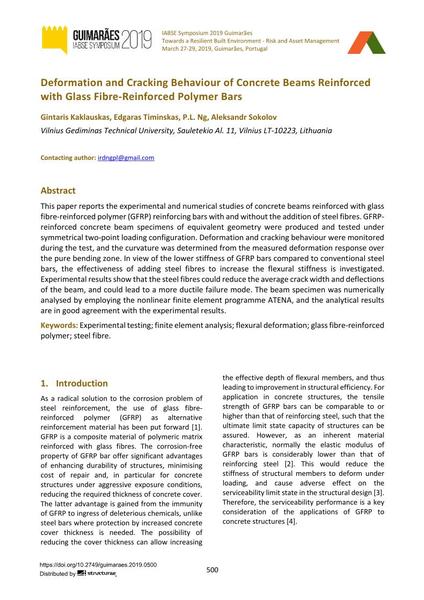Deformation and Cracking Behaviour of Concrete Beams Reinforced with Glass Fibre-Reinforced Polymer Bars

|
|
|||||||||||
Détails bibliographiques
| Auteur(s): |
Gintaris Kaklauskas
(Vilnius Gediminas Technical University, Sauletekio Al. 11, Vilnius LT-10223, Lithuania)
Edgaras Timinskas (Vilnius Gediminas Technical University, Sauletekio Al. 11, Vilnius LT-10223, Lithuania) P. L. Ng (Vilnius Gediminas Technical University, Sauletekio Al. 11, Vilnius LT-10223, Lithuania) Aleksandr Sokolov (Vilnius Gediminas Technical University, Sauletekio Al. 11, Vilnius LT-10223, Lithuania) |
||||
|---|---|---|---|---|---|
| Médium: | papier de conférence | ||||
| Langue(s): | anglais | ||||
| Conférence: | IABSE Symposium: Towards a Resilient Built Environment Risk and Asset Management, Guimarães, Portugal, 27-29 March 2019 | ||||
| Publié dans: | IABSE Symposium Guimarães 2019 | ||||
|
|||||
| Page(s): | 500-506 | ||||
| Nombre total de pages (du PDF): | 7 | ||||
| DOI: | 10.2749/guimaraes.2019.0500 | ||||
| Abstrait: |
This paper reports the experimental and numerical studies of concrete beams reinforced with glass fibre-reinforced polymer (GFRP) reinforcing bars with and without the addition of steel fibres. GFRP- reinforced concrete beam specimens of equivalent geometry were produced and tested under symmetrical two-point loading configuration. Deformation and cracking behaviour were monitored during the test, and the curvature was determined from the measured deformation response over the pure bending zone. In view of the lower stiffness of GFRP bars compared to conventional steel bars, the effectiveness of adding steel fibres to increase the flexural stiffness is investigated. Experimental results show that the steel fibres could reduce the average crack width and deflections of the beam, and could lead to a more ductile failure mode. The beam specimen was numerically analysed by employing the nonlinear finite element programme ATENA, and the analytical results are in good agreement with the experimental results. |
||||
